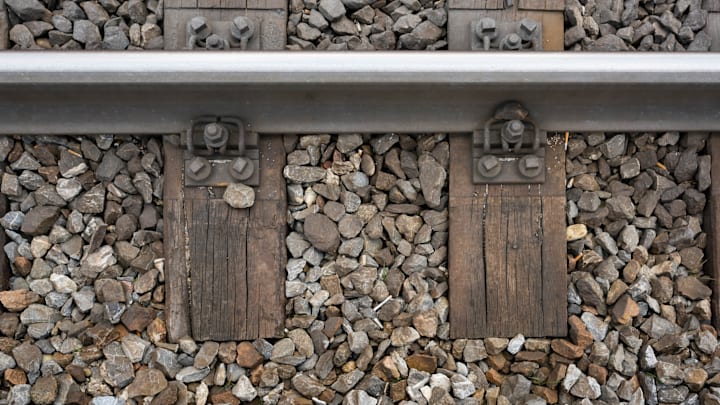Train tracks may be a seemingly simple innovation, but that means that each component plays a critical role. The rails themselves guide the train, the wooden ties anchor the rails and distribute the train’s weight, and the fasteners are steel spikes linking the two together. But what might not be so clear is the purpose of all those rocks under and around the tracks. Their job isn’t immediately obvious, but it’s just as important.
Under Pressure
Those rocks, usually crushed granite or limestone (or recycled concrete or slag, in recent, eco-friendly years), serve multiple purposes that protect trains, the rails they run on, and the environment. For one, they provide essential safety and stability. Their weight and distribution around the tracks helps evenly spread out the immense pressure and weight of a passing train, preventing the rails and ties from warping and becoming misaligned.
Of course, this means the tracks last longer, which is good for costs; but more importantly, it prevents disastrous derailing accidents. In fact, as train cars have gotten heavier over the years, the stones have had to be spread even farther out alongside the tracks to accommodate the weight. The essential role these rocks play in keeping trains and their tracks steady is why they’re referred to as ballast, originally a maritime term for stones used to stabilize ships.
You May Also Like:
- Why Are the Metal Bars on Some Windows Curved?
- Why Did We Stop Building Covered Bridges?
- What Are Those Weird Sleeves on California Gas Pumps?
Add Mental Floss as a preferred news source!
Multi-purpose
Ballast also protects railroad tracks from natural wear and tear. They provide excellent drainage around the tracks, preventing rainwater from settling in and weakening both the ties and the tracks’ foundation. Similarly, they discourage vegetation from growing up around the tracks. Plants trap moisture, and their roots would loosen and therefore weaken the ground under the tracks. But the drainage, as well as blocked access to sunlight, that ballast provides keeps them at bay.
For ballast to be effective at all of these tasks, it has to be sharp. If smooth, loose stones were used as ballast, they would slip and slide all over each other when a train passed over. The angular edges of sharp rocks, however, cause them to lock into one another and not move, creating a more stable base that absorbs as much weight and vibration as possible.
To Ballast or Not to Ballast

You may have noticed, however, that some more modern tracks don’t have ballast around them at all. These tracks are called, aptly, “ballastless track systems.” They were initially developed in light of advancing technologies. As train track parts have improved, ballast has become the weak link: It needs replacing most frequently of any of the parts. So instead of ballast, in these newer systems, the ties are fastened to layers of concrete on the ground. The result is railroad tracks that require less maintenance and actually stay better-aligned over time. For this reason, it’s a common choice for high-speed passenger rail, which requires greater track accuracy to safely maintain top speeds.
In all, train track ballast isn’t just for show, but is a vital part of keeping many trains—plus the people and goods on them—safely and efficiently en route to their destination. So next time you’re boarding a train, take a moment to appreciate the big impact of these little rocks.
